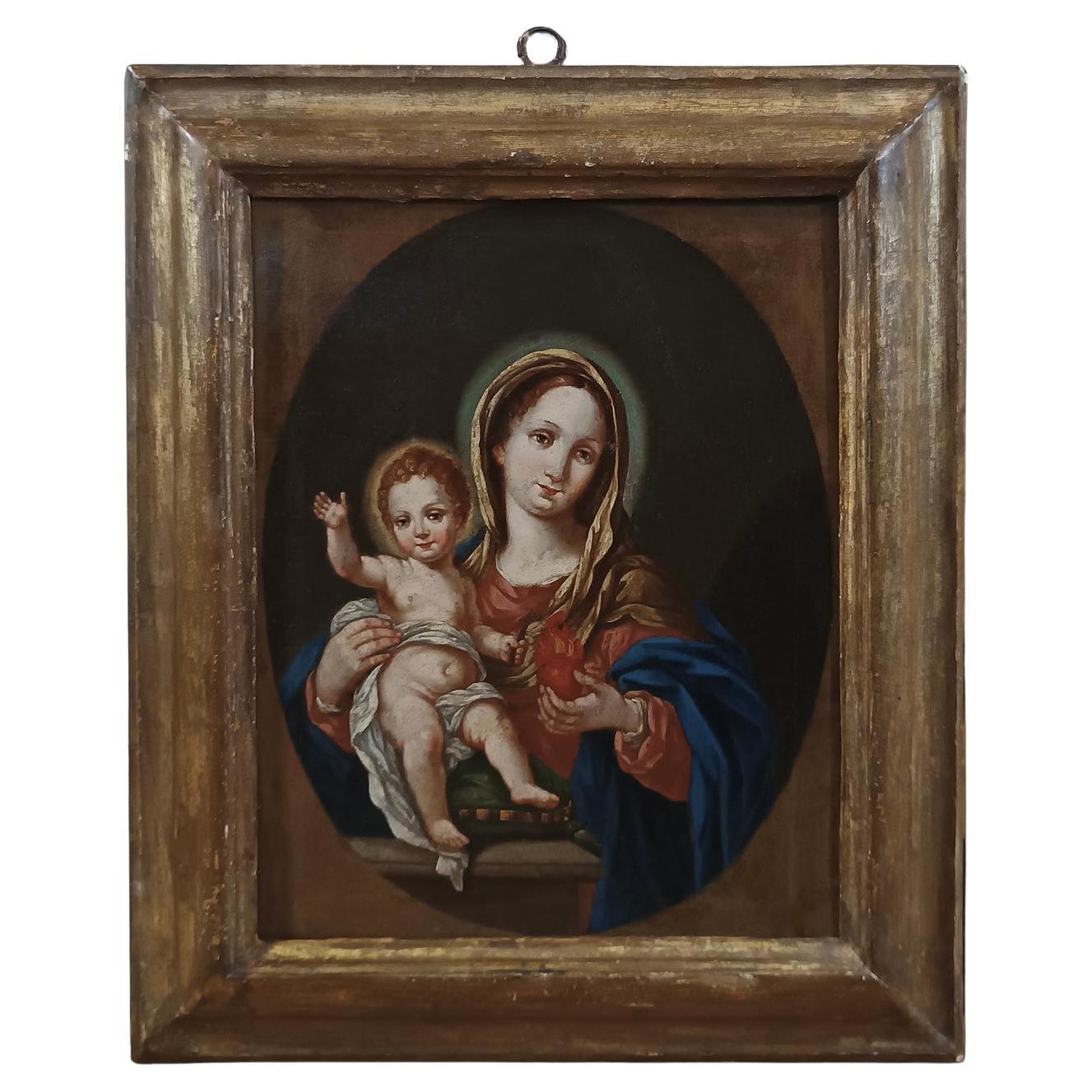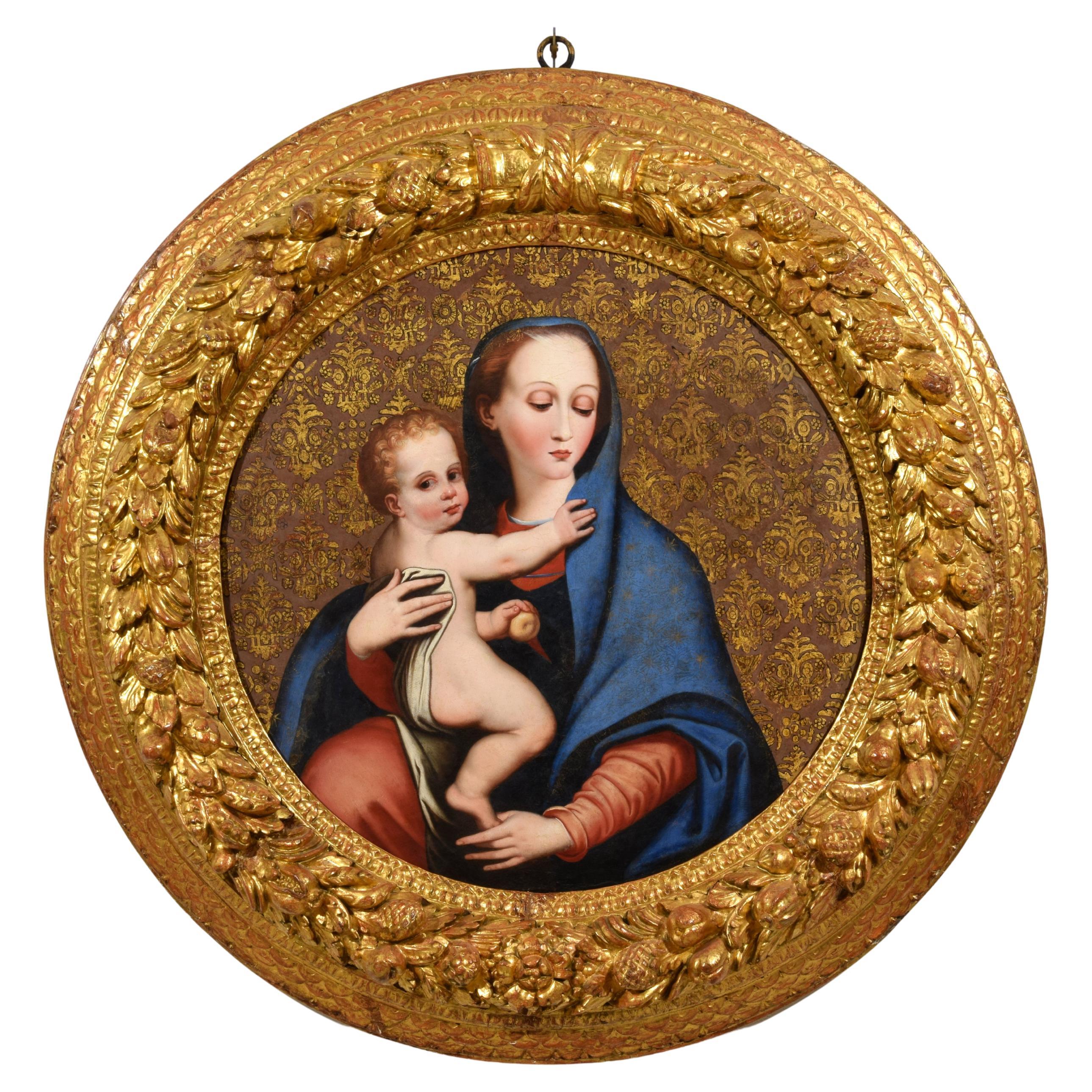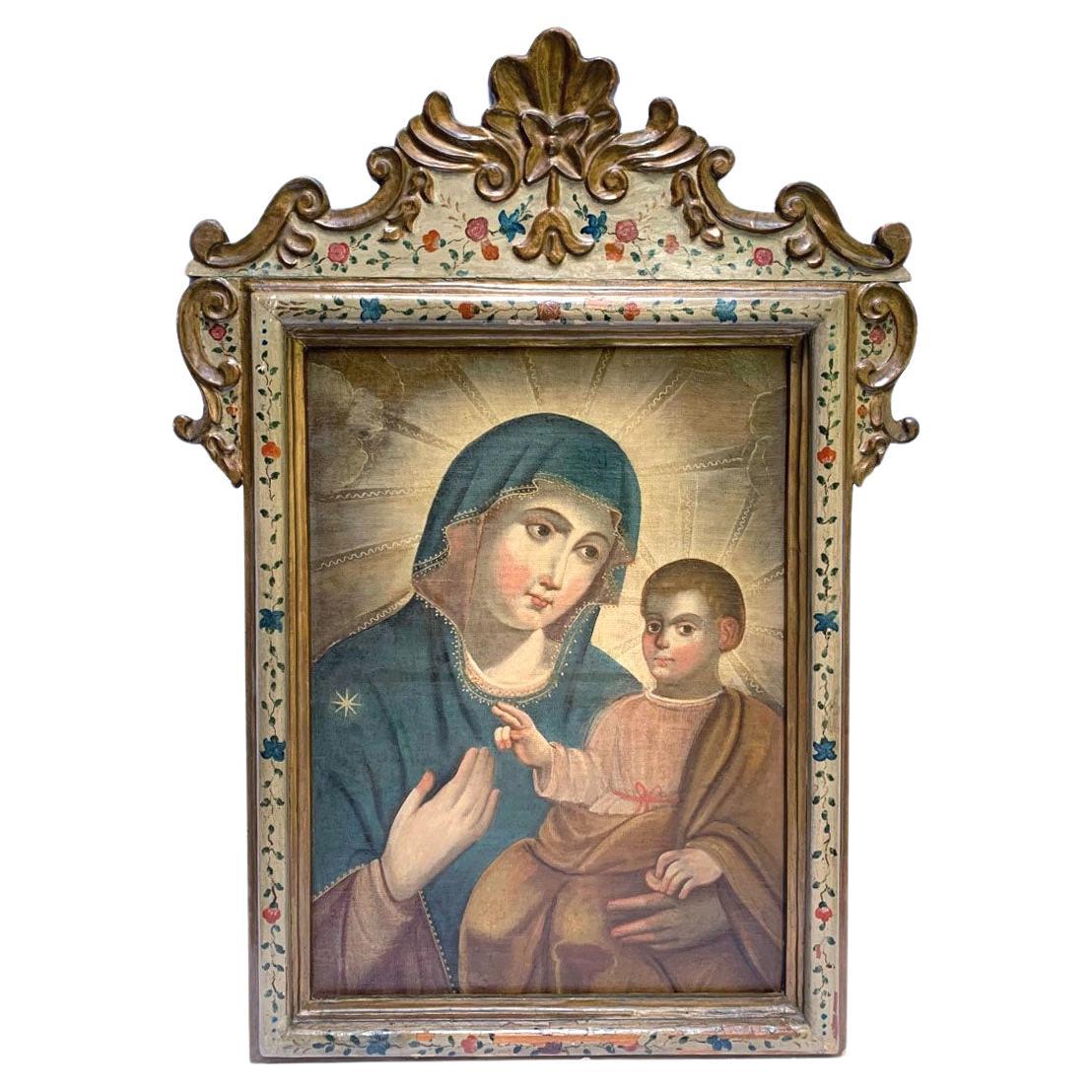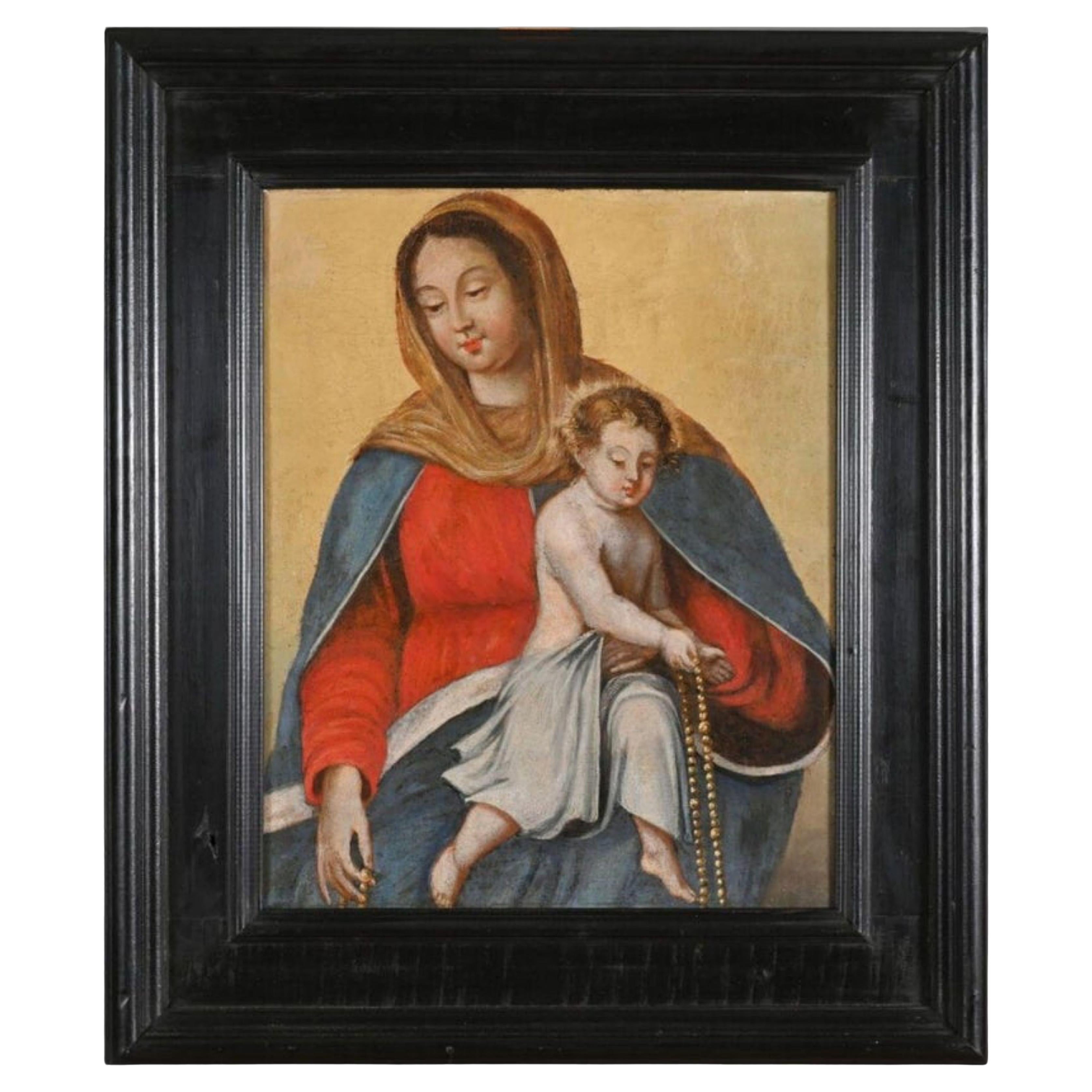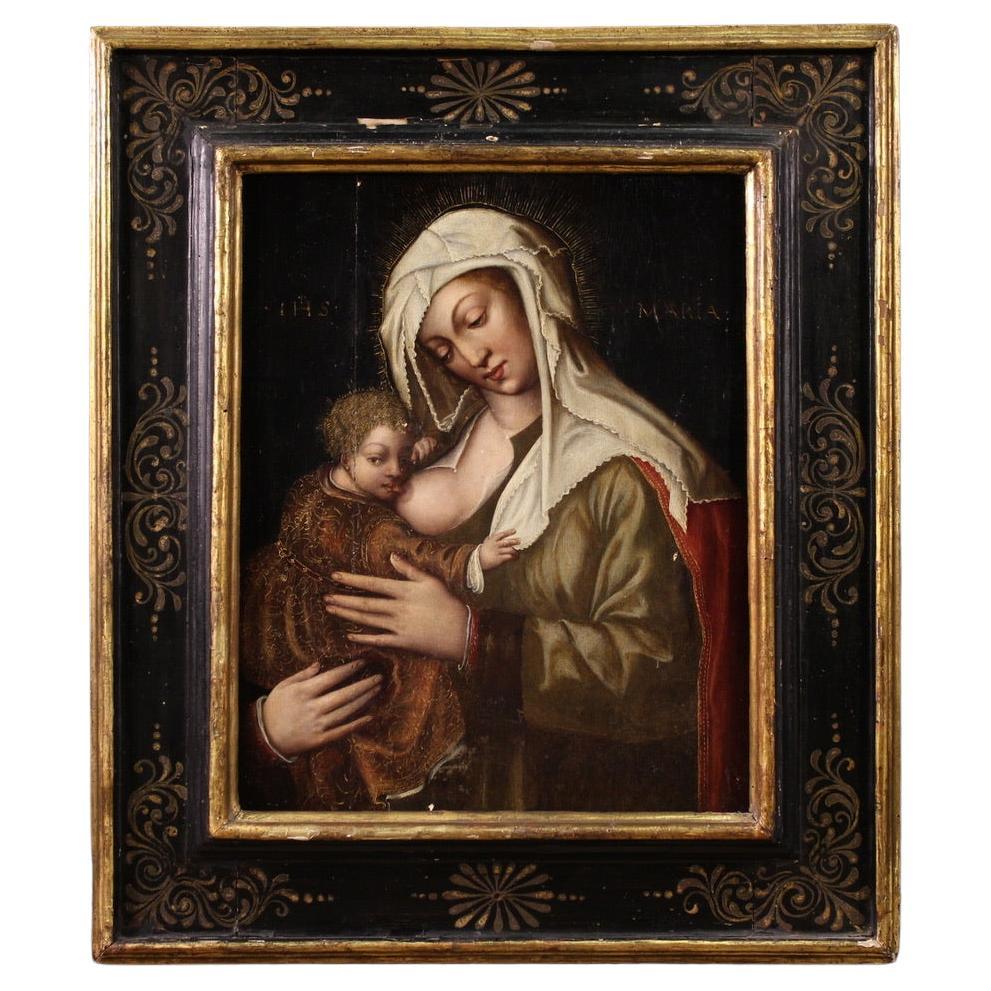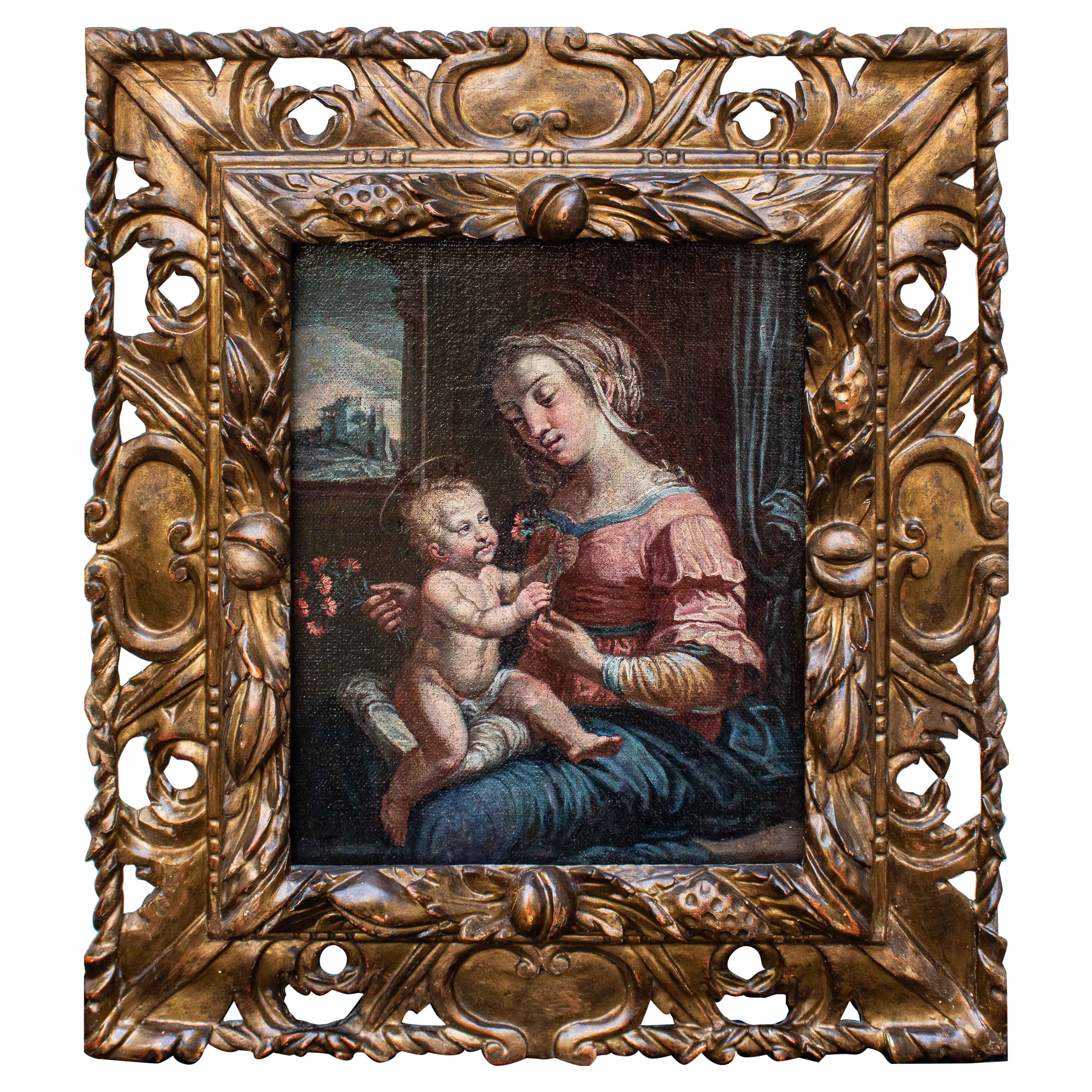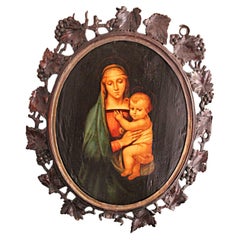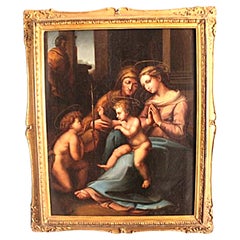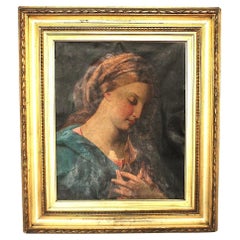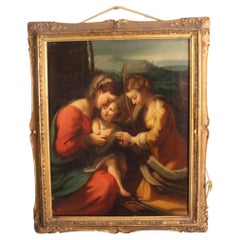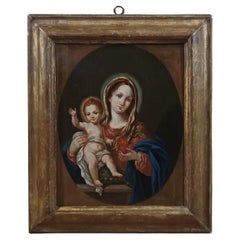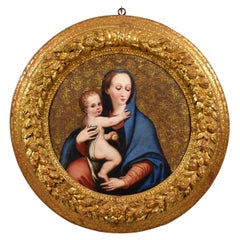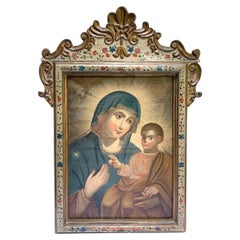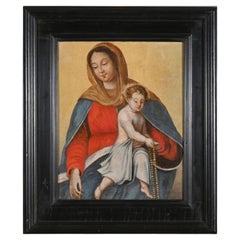Items Similar to Flemish 16th century Madonna in a Rose Garden
Video Loading
Want more images or videos?
Request additional images or videos from the seller
1 of 18
Flemish 16th century Madonna in a Rose Garden
$10,777.27
£7,860
€9,166.95
CA$14,757.77
A$16,408.63
CHF 8,567.68
MX$199,732.98
NOK 109,319.88
SEK 102,427.50
DKK 68,414.65
Shipping
Retrieving quote...The 1stDibs Promise:
Authenticity Guarantee,
Money-Back Guarantee,
24-Hour Cancellation
About the Item
The Madonna and Child Oil Painting in a Rose Garden – Flemish (Ambrosius Benson School)
Late 16th Century/ Early 17th Century Flemish Oil Painting on Oak Panel
Artist & Background
This exquisite Flemish Renaissance Madonna and Child oil painting, titled Madonna and Child in a Rose Garden, is attributed to a follower of Ambrosius Benson (circa late 16th - early 17th century). Benson, originally from Lombardy, Italy, became a renowned master painter in Bruges, Flanders, in the early 1500s..
Key Features of This Madonna and Child Painting:
Period & Style – Late 16th-century Flemish School, influenced by Gerard David and Leonardo da Vinci.
Medium – Oil on oak panel, a signature technique of Flemish masters.
Composition – The Virgin Mary and Christ Child are set in a serene rose garden, symbolising purity and divine love.
Influence – This artwork reflects both Netherlandish precision and Lombard artistic traditions.
Provenance & Demand: Benson’s followers were widely sought after, and his compositions commanded high market value among collectors.
Antique Hand-Carved Frame Old Master Madonna and Child Artwork
This painting is housed in an original 17th-century hand-carved wooden frame featuring a classic egg-and-dart motif.
Condition Report
Conservation Status: Professionally cleaned.
Historical Cracking: Some age-related panel cracks are common in antique oil paintings.
Restoration: Minor retouching to the Madonna’s face, enhancing original details.
Why Invest in Flemish Renaissance Art?
Historical Significance – Works by Ambrosius Benson’s followers remain highly collectable in the art market.
Museum-Quality Piece – Suitable for private collectors, investors, and art connoisseurs.
European Heritage – A fine example of an Old Master religious painting with an authentic provenance and period frame.
This rare Madonna and Child painting is a remarkable investment for collectors of Renaissance religious art. Don't miss this opportunity to own an exceptional piece of 16th- 17th-century Flemish artistry.
- Dimensions:Height: 26.78 in (68 cm)Width: 19.3 in (49 cm)Depth: 1.97 in (5 cm)
- Style:Renaissance (Of the Period)
- Materials and Techniques:
- Place of Origin:
- Period:1610-1619
- Date of Manufacture:1610
- Condition:Repaired: Previous repairs for a crack in the panel. The painting has been cleaned and retouched areas to the hand and face of the madonna. Minor losses. Minor structural damages.
- Seller Location:Seaford, GB
- Reference Number:1stDibs: LU10376244352062
About the Seller
New to 1stDibs
Joined in the past six months.
No Reviews Yet
Vetted Professional Seller
Every seller passes strict standards for authenticity and reliability
Established in 2021
1stDibs seller since 2025
Typical response time: 1 hour
- ShippingRetrieving quote...Shipping from: Seaford, United Kingdom
- Return Policy
Authenticity Guarantee
In the unlikely event there’s an issue with an item’s authenticity, contact us within 1 year for a full refund. DetailsMoney-Back Guarantee
If your item is not as described, is damaged in transit, or does not arrive, contact us within 7 days for a full refund. Details24-Hour Cancellation
You have a 24-hour grace period in which to reconsider your purchase, with no questions asked.Vetted Professional Sellers
Our world-class sellers must adhere to strict standards for service and quality, maintaining the integrity of our listings.Price-Match Guarantee
If you find that a seller listed the same item for a lower price elsewhere, we’ll match it.Trusted Global Delivery
Our best-in-class carrier network provides specialized shipping options worldwide, including custom delivery.More From This Seller
View All19th century After Rahael Grand Duke’s Madonna Painting
By (after) Raphael (Raffaello Sanzio da Urbino)
Located in Seaford, GB
After Raphael's Grand Duke's Madonna
Grand Duke's Madonna after Raphael, a stunning 19th-century oil painting from the renowned Berkley Collection. This remarkable artwork, inspire...
Category
Antique Late 19th Century Italian Renaissance Paintings
Materials
Paint, Paper
$1,809 Sale Price
20% Off
After Raphael The Madonna Of Divine Love oil on canvas
By (after) Raphael (Raffaello Sanzio da Urbino)
Located in Seaford, GB
Early 19th-Century Italian School Oil on Canvas – After Raphael
The Holy Family with Saint Elisabeth and the Infant Saint John the Baptist
Introduction: A Masterpiece Inspired by Rap...
Category
Antique Early 19th Century Italian Renaissance Paintings
Materials
Canvas
Studio of Pompeo Batoni, “Madonna of the Annunciation– Mid-18th Century Italian
Located in Seaford, GB
Country HouseAn exceptional mid-18th-century oil painting from the Studio of Pompeo Batoni (1708–1787), presenting a revered composition: The Madonna of the Annunciation. This rema...
Category
Antique Mid-17th Century Italian Grand Tour Paintings
Materials
Canvas
18th century Antonio Correggio The Mystic Marriage of St Catherine
By Antonio da Correggio
Located in Seaford, GB
Antonio Correggio’s The Mystic Marriage of St. Catherine
This stunning 18th-century copy draws inspiration from the masterpiece The Mystic Marriage of Saint Catherine, originally pa...
Category
Antique Mid-19th Century Italian Renaissance Paintings
Materials
Canvas
$2,413 Sale Price
20% Off
Exquisite 19th Century English Still Life of wild flowers– Oil on Wood Panel
Located in Seaford, GB
A captivating and finely executed 19th-century English still life painting, rendered in oil on wood panel, depicting an abundant bouquet of mixed flowers in a terracotta urn. This hi...
Category
Antique 19th Century English High Victorian Paintings
Materials
Paint
17th century portrait of Mrs Voss and Catherine Kneller oil canvas
By Sir Godfrey Kneller
Located in Seaford, GB
Circle of Sir Godfrey Kneller, Mrs Voss, and Catherine Kneller, oil on paper laid to wood panel
Overview
This exceptional Baroque portrait artwork, the circle of Sir Godfrey Kneller, is an oil on canvas painting from the early 18th century. The painting, laid onto a panel, represents a compelling historical piece linked to Mrs. Voss, who was active circa 1685-1690 and recognized as the mistress of Sir Godfrey Kneller and the mother of Catherine (Agnes) Huckle.
Key Details: Sir Godfrey Kneller, Mrs Voss and Catherine Kneller oil canvas
Medium: Oil on paper, laid onto panel
Period: Early 18th century
Condition: Unframed oil panel
Dimensions: Height - 28 inches, Width - 34 inches
Historical Connection: A larger version of this artwork is held in the Kingston Lacy Estate, Dorset
Artist Influence: Connected to the circle of Sir Godfrey Kneller, one of the most influential portrait artists of the Baroque period.
This Old Master portrait painting is a fine example of Kneller’s portrait style, making it a sought-after piece for collectors, historians, and art enthusiasts looking to buy antique paintings in Sussex or the UK.
About Sir Godfrey Kneller (1646-1723)
Sir Godfrey Kneller (born Gottfried Kniller) was a renowned Baroque portrait painter of Anglo-German descent, widely considered one of the greatest portraitists of the late 17th and early 18th centuries. His influence on English portraiture was significant, and his works remain highly collectable today.
1. Early Life and Training
Birth: August 8, 1646, Lübeck, Germany
Parents: Zacharias Kniller (merchant) and Lucia Kniller
Education:
Studied painting in Lübeck
Trained in Amsterdam under Ferdinand Bol (a student of Rembrandt)
Influenced by the Dutch Golden Age art movement
During his training, Kneller adopted techniques from Rembrandt and Bol, shaping his mastery of light, shadow, and lifelike portraiture.
2. Italian Influence and Artistic Growth Sir Godfrey Kneller Mrs Voss and Catherine Kneller oil canvas
Traveled to Italy in the early 1670s to study Titian, Veronese, and Caravaggio
His exposure to Italian Renaissance and Baroque art deepened his understanding of color theory, composition, and grand portraiture
After returning to Northern Europe, he briefly worked in Hamburg before moving to England in 1676
3. Kneller’s Rise in England and Royal Patronage
His talent quickly gained recognition among the English aristocracy and royalty
In 1680, he was appointed Principal Painter to King Charles II
Over his career, Kneller painted portraits of five English and British monarchs:
King Charles II
King James II
King William III & Queen Mary II
Queen Anne
King George I
His iconic portrait paintings continue to serve as historical records of British nobility, making his works highly valuable in the art market.
4. Notable Works and Contributions
Kit-Cat Club Portraits: A famous series of 48 portraits of prominent literary, political, and cultural figures of the time.
Developed the grand yet lifelike Baroque portrait style, balancing realism with nobility.
His influence on later English portrait painters, such as Thomas Gainsborough and Joshua Reynolds, was profound.
5. Kneller’s Honors and Legacy
Knighted by King William III in 1692
Created a Baronet by King George I in 1715
Naturalized British Citizen in 1711
Passed away on October 19, 1723, and was buried in Twickenham, England.
His works remain highly collectible, sought after by art collectors, historians, and museums worldwide.
Historical & Artistic Significance of the Painting
This early 18th-century oil portrait attributed to Kneller’s circle is an outstanding example of his influence on Baroque portraiture. The depiction of Mrs. Voss and her connection to Catherine (Agnes) Huckle adds historical depth and collector value.
1. Artistic Style and Features
Detailed brushwork characteristic of Kneller’s school
Rich color palette influenced by Titian and Rembrandt
Noble posturing typical of 17th-18th century aristocratic portraiture
Use of light and shadow to enhance depth and realism
2. Collector’s Appeal & Investment Potential
Highly sought-after Old Master artwork with documented provenance
Strong appeal to art collectors, historians, and museums
Valuable addition to Baroque art collections
Investment-worthy due to high demand for Kneller’s works in auctions and private sales
3. Comparison to the Kingston Lacy Version
A much larger version of this painting exists in the Kingston Lacy Estate, Dorset
This smaller panel version offers collectors a unique opportunity to own a historically significant work at a more accessible scale and price
Final Thoughts
The circle of Godfrey Kneller oil on canvas painting featuring Mrs. Voss and Catherine (Agnes) Huckle is an important historical artwork. Whether you are an art collector, investor, or historian, this painting represents a rare opportunity to acquire a piece of Baroque portraiture.
Why This Painting is a Must-Have for Collectors:
Authentic Old Master Portrait from the School of Kneller
Strong Historical and Artistic Value
Investment Potential in the Art Market
Connected to the Kingston Lacy Collection
Ideal for Collectors of English Baroque Portraits...
Category
Antique 1690s British Baroque Paintings
Materials
Canvas
You May Also Like
MID-18th CENTURY PAINTING MADONNA WITH CHILD
Located in Firenze, FI
Beautiful oil painting on canvas, made on the first canvas and framed with a contemporary rectangular frame in carved and gilded wood. The painting represents a striking image of the...
Category
Antique Mid-18th Century Italian Paintings
Materials
Canvas, Wood, Paint
17th Century, Italian Oil on Panel Painting Depicting Madonna della Purità
Located in IT
17th Century, Italian Oil on Panel Painting Depicting Madonna della Purità
The painting, executed in oil on a circular wooden panel and presented in an imposing carved and gilded wo...
Category
Antique 17th Century Italian Renaissance Paintings
Materials
Wood, Giltwood
Magnificent 18th Century Venetian Madonna
Located in Rio De Janeiro, BR
Great oil on canvas depicting Madonna and Child. Carved, gilded and polychrome wooden frame with floral arrangements. Venetian, 18th Century.
Dimensions in centimeters: CANVAS 69cm H x 51cm / FRAME 107cm H x 80cm.
In art, a Madonna is a representation of Mary, either alone or with her child Jesus. These images are central icons for both the Catholic and Orthodox churches. The word is from Italian ma donna 'my lady' (archaic). The Madonna and Child type is very prevalent in Christian iconography, divided into many traditional subtypes especially in Eastern Orthodox iconography, often known after the location of a notable icon of the type, such as the Theotokos of Vladimir...
Category
Antique Mid-18th Century Italian Baroque Paintings
Materials
Canvas
17th century French School "Virgin and Child (Virgin of the Rosary)"
Located in Madrid, ES
17th century French School
"Virgin and Child (Virgin of the Rosary)"
Oil on canvas (Fragment, original canvas, tension bands, restorations)
47.3 x 37.9 cm
This canvas was probably...
Category
Antique 17th Century French Baroque Paintings
Materials
Paint
16th Century Oil on Canvas Italian Religious Painting Madonna with Child, 1520
Located in Vicoforte, Piedmont
A rare 16th-century Italian painting. An oil on panel painting depicting a refined Madonna with Child, this artwork is of extraordinary pictorial quality. The most popular iconograph...
Category
Antique 16th Century Italian Paintings
Materials
Canvas
16th Century Madonna of the Carnations Painting Oil on Canvas from Raffaello
By Raphael (Raffaello Sanzio da Urbino)
Located in Milan, IT
16th century, by Raffaello Sanzio (Urbino, 1483 - Rome, 1520)
Madonna of the Carnations
Measures: Oil on canvas 38 x 30 - with frame 59 x 52.5 cm
The Madonna dei Garofani made b...
Category
Antique 16th Century Italian Paintings
Materials
Canvas
More Ways To Browse
Italian Art Antique Painted Religious
Terracotta Ball
Thai Figures
Thai Gilt Bronze
Thai Porcelain
Tiffany Silver Sterling Frame
Tulip Chrome Table
Used Furniture Perth
Used Hotel Furniture In Las Vegas
Vintage 18 Wheelers
Vintage Brownstones
Vintage Deer Plate
Vintage German Teapots
Vintage Green Glass Footed Bowl
Vintage Skates
Vintage Stone Crusher
Vintage Stone Shoes
Windsor Dining Table
